Style
Two Mexico City Design Stars Helped Cartier Unlock Histories Hidden in Its Jewels in a New Exhibition
The famed French maison invited Frida Escobedo and Ana Elena Mallet to dive into its archives.
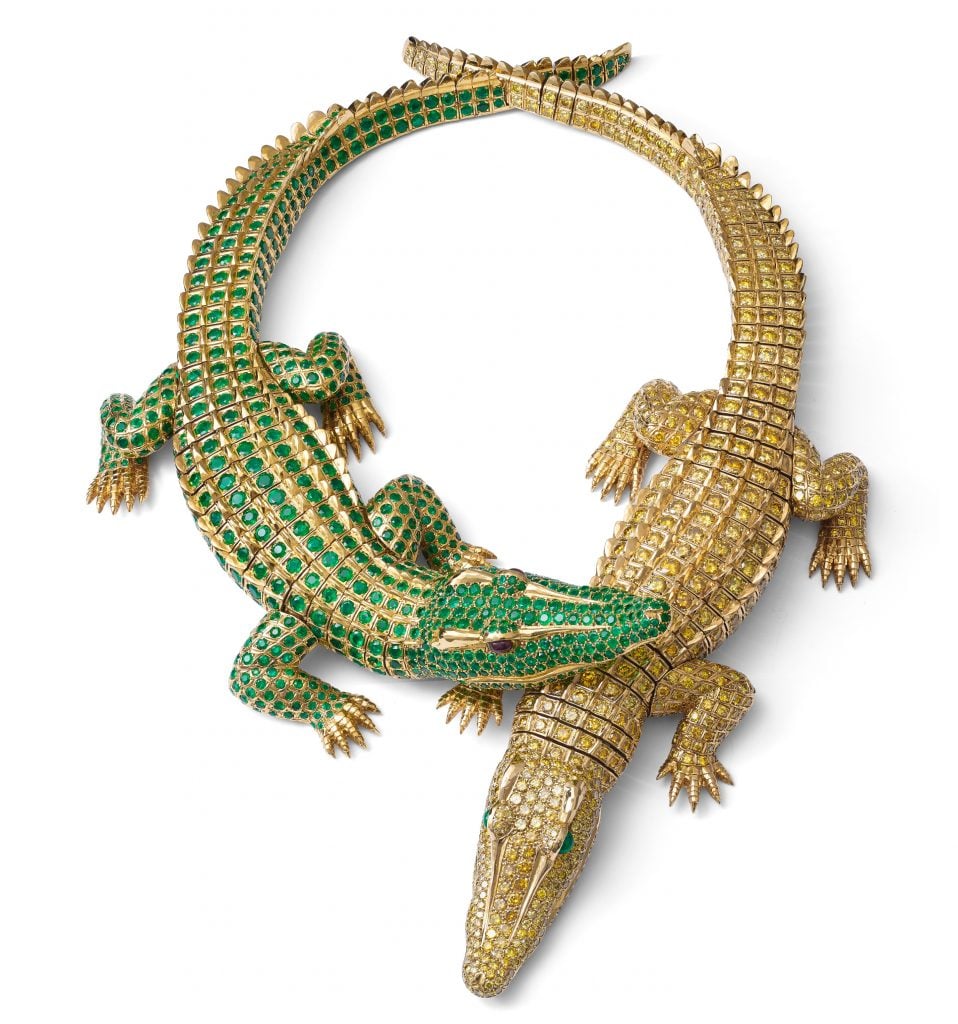
The famed French maison invited Frida Escobedo and Ana Elena Mallet to dive into its archives.

William Van Meter

In a store vitrine, jewelry shows us what we want. In a museum display case, it tells the story of who we are. “It’s not a jewelry show,” said the curator Ana Elena Mallet of the recently opened exhibition “Cartier Design: A Living Legacy,” at Mexico City’s Museo Jumex. “It’s a design show.”
Mallet was enjoying a moment of reflection over coffee the day after the glamorous opening gala. Elaborating on the broader themes she sought to draw out, she added, “It’s a cultural lecture on jewels and what has happened in the world.”
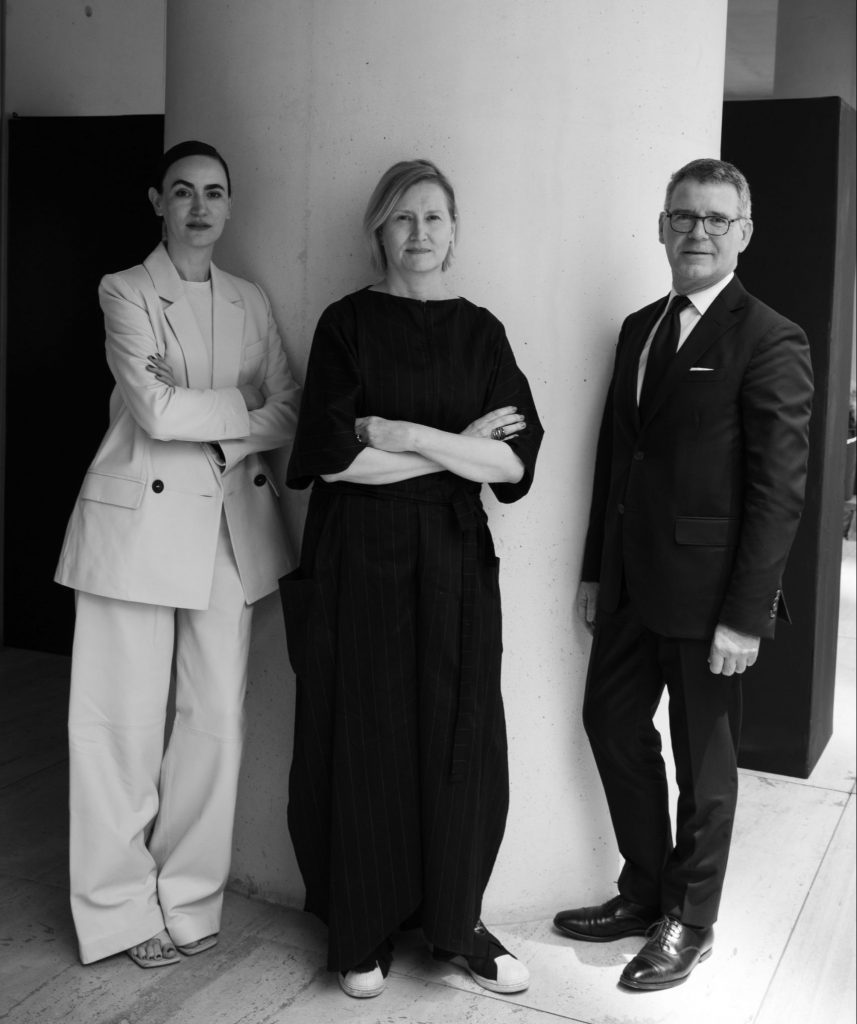
The architect and scenographer Frida Escobedo, curator Ana Elena Mallet, and Cartier’s Image, Style, and Heritage director, Pierre Rainero, at the Museo Jumex in Mexico City on March 14, 2023. Courtesy of Cartier.
With more than 160 magnificent pieces in this exhibition—which runs through May 14 and also includes plaster casts, drawings, photos, and ephemera—the selection certainly dazzles. But also it telegraphs universal stories and reveals deeper truths.
“A Living Legacy” is the first in a planned trio of site-specific shows that mine the riches of the Cartier Collection, the luxury house’s vast archive. Starting in 1973, it has been devoted to researching and acquiring culturally significant pieces created since its 1847 founding. The next tranche of treasures will go on view at Hong Kong Palace in April, followed by a yet-to-be-revealed Middle East location later this year. And with each iteration, local talent has been given carte blanche to shape a narrative with the archive.
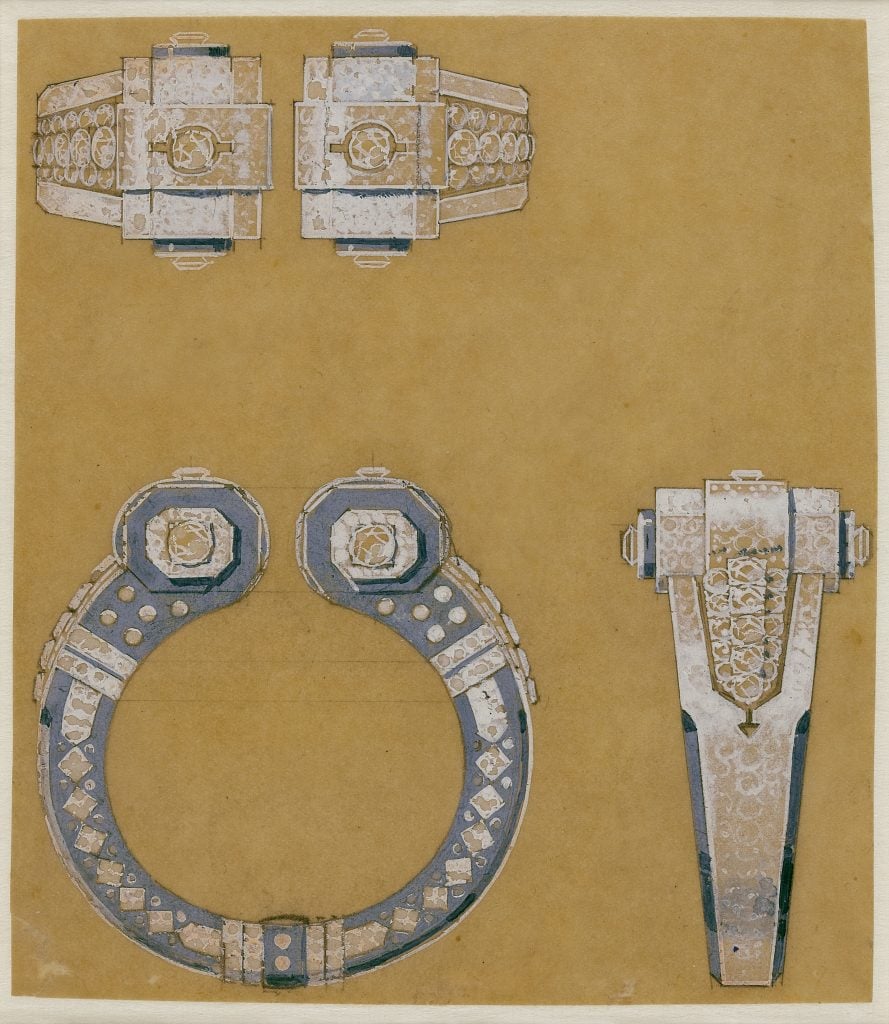
Design for a bracelet (1934) to be executed in platinum and diamonds by Cartier Paris. Graphite and gouache on tracing paper. Courtesy Cartier Paris Archives.
In Mexico City, Cartier turned to the art and design curator Mallet and the architect Frida Escobedo, who served as scenographer (one of her next projects is revamping a portion of the Met—she will be the first woman to design one of its wings). Both brought an emotional connection and personal history to the Cartier project, and their passion is evident in the result. In fact, a 1999 Cartier Collection exhibition at the Museo del Palacio de Bellas Artes changed the course of Mallet’s career.
“I was just starting out in museums,” she recalled. “The director was a good friend and brought me to the opening. It was really moving. I’m a design curator. But at that time, I wanted to be a contemporary art curator. But really looking and understanding that those objects could be in our main museum, that jewelry could be in our beloved temple of exhibitions—that was important for me. I saw that jewelry belongs in museums, and that you can read jewelry as historical and aesthetic objects, and it could give you another take on the history of art.”
For Escobedo, the opportunity channeled childhood memories. “When Cartier approached me to do an exhibition, I said yes, because it connects me to my grandfather,” she explained. “He was a watchmaker. His house was filled with Sotheby’s catalogs. We’d visit him on Sunday afternoon, and he’d open these books and explain the mechanisms and tiny pieces. The miniatures were always fascinating, in the terms of the scale and the amount of technology that goes into a little box to mark time. Cartier was a big reference to him because he knew all of the different timepieces—the Santos, the Tank, all of them.”
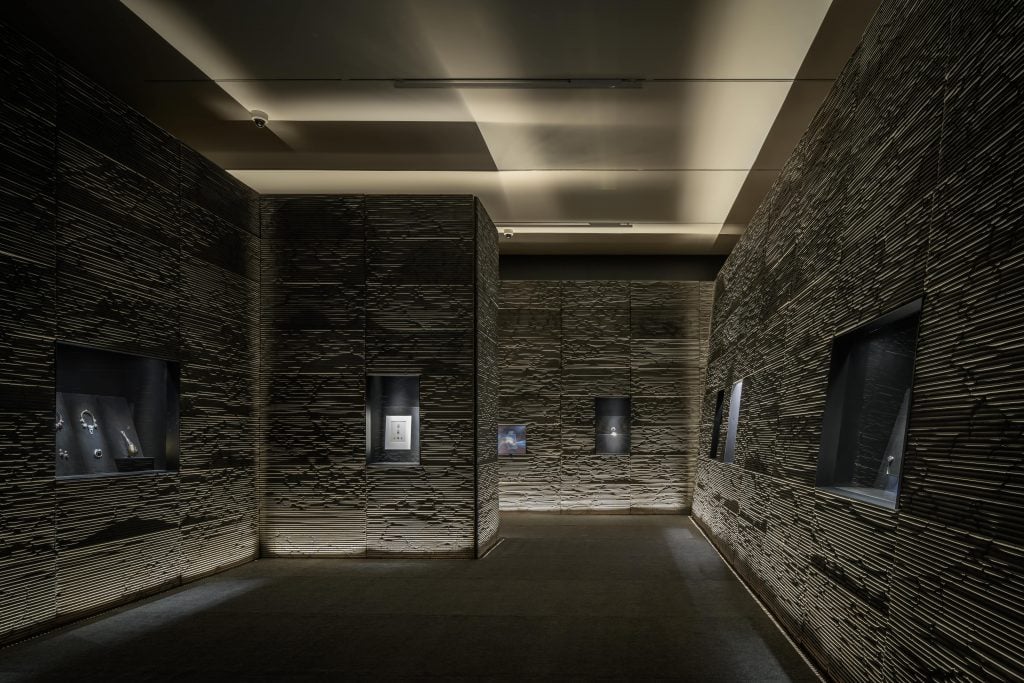
Installation view, “Cartier Design: A Living Legacy.” Museo Jumex, 2023. Photo: Moritz Bernoully.
The idea to build a minimalist, meditative mineshaft was almost immediate. Entering viewers go on an excavation-like journey. “It was very intuitive and a clear concept from the beginning,” Escobedo said. She worked with the artist Rodolfo Díaz Cervantes and the Mexico City workshop she’s collaborated with for 20 years, Taller Tornel, to develop the 950 textured, undulating concrete panels that line the walls. “It wraps you up in this single cohesive narrative,” she said. “You can see the handcraft in the panels, the idea of repetition. The material deflects the sound of people talking; it creates a complete atmosphere. Then of course, it relates to the idea of strata, something that is made through many layers of history.”
Frankly, the setup also inspires some serious interiors envy—until stepping into “A Living Legacy,” you never knew you’d want to move into the museum version of a dimly lit quarry. But as chic and memorable as the scenography is, it doesn’t overshadow the artifacts and never fails the ultimate purpose to serve the objects—a tricky feat when dealing with such small-scale items.
A section of the show is called “Wearing Beauty and Measuring Time,” and here Cartier’s illustrious timepieces are showcased. There are desk clocks in jade and rock crystal; pocket watches and brooches with teensy clock faces demurely hidden on their undersides, and of course, a broad spectrum of watches—including the coveted Crash, a Dalíesque melting metaphor for the wrist. It’s in this hall of horology that one of the show’s meanings truly strikes: this really isn’t just about timepieces but about time itself.
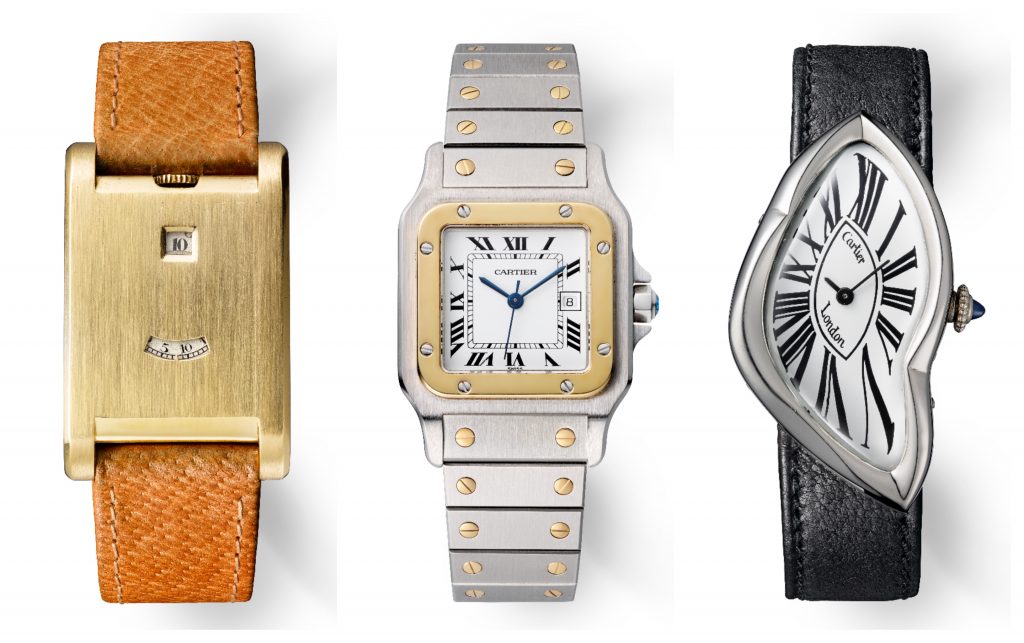
From left to right: Tank à Guichets wristwatch (1928) produced by Cartier Paris for Sir Bhupindra Singh, Maharaja of Patiala; Santos wristwatch (large model; 1996) with self-winding movement; and Crash wristwatch (1990), produced by Cartier London. Photos: Vincent Wulveryck, all courtesy of Cartier.
But alongside the beautifully useful wristwatches and technological wonders like the “mystery clocks” with floating hands, the curators have selected a broad range of fabulous obsolescence. There is a diamond-encrusted cigarette holder, gold lipstick holders, and vanity and cigarette cases galore—all exquisite, all anachronistic. Taken together, it is a statement about who we were and what was important, the fluctuating definition and ephemerality of luxury. But jewelry by definition needn’t be utilitarian, and who doesn’t need an extra diadem or two?
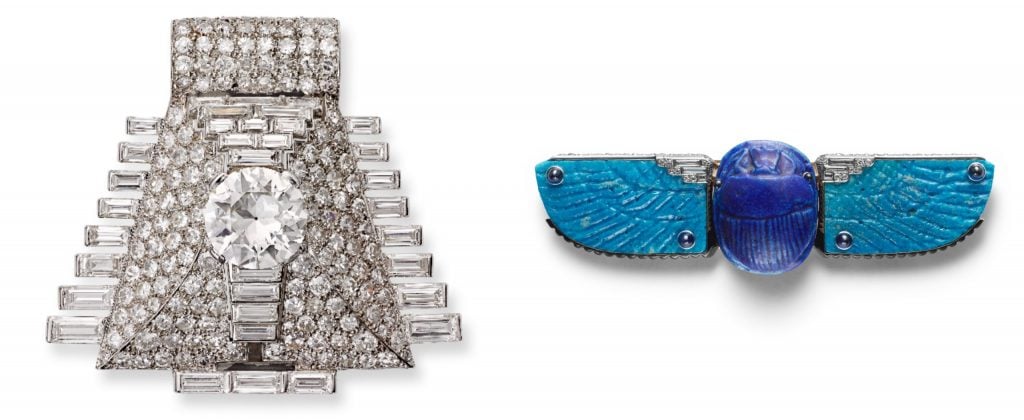
Left: Pyramid clip brooch (1935) in platinum and diamonds by Cartier Paris. For this special order, two identical clip brooches were made to be worn separately or as a single piece; Right: Scarab belt buckle (1926) in gold, platinum, blue Egyptian faience, diamonds, sapphires, and black enamel, by Cartier Paris. Sold to Mrs. Cole Porter. Photos: Vincent Wulveryc (left) and Marian Gérard (right), courtesy of Cartier.
But as one wanders this nexus of a show, time and space blur and overlap. The Orientalist craze of the 1920s veers into minimalist futurist Zen in the same era. Thematic links to Mexico pop up with pieces that echo Aztec pyramids and brooches that emulate native fauna. Cartier’s own motifs, including the deceptively candy-like Tutti Frutti jumble, repeat and reverberate, as when a 2003 necklace is placed next to its 1953 counterpart.
The exhibition also speaks to the changing identity of the brand, charting the fashions and trends the timeless and austere Cartier of today took part in. Typically, for a show like this the wall labels would contain exhaustive notes on carats and stone sourcing; instead, the texts display surprising restraint.

Tutti Frutti strap bracelet (1925) in platinum, diamonds, sapphires, rubies, emeralds, onyx, and black enamel by Cartier Paris. Photo: Nils Herrmann, courtesy of Cartier.
For instance, the simple identifier “Brooch, Cartier Paris, 1922” accompanies one of the more-intricate amalgamations of diamonds and emeralds. The viewer is liberated to contemplate the design of the object and not mentally tally the price (though if he wants to delve deeper, there is a QR code). This sense of mystery and discovery heightens the connective experience. “I wanted people to focus on the object,” Mallet said, “on the formality and the design. No metals, stones, or provenance! Let people enjoy the objects.” Besides the optional QR deep dive, visitors can glimpse the intricacy of certain pieces in staggering 3D animated projections.

Curator Ana Elena Mallet worked with the French company Iconem on the 3-D projections. Courtesy of Cartier.
A new creative partnership was formed incubating the show. “I’ve known Ana Elena since forever,” Escobedo said. “But this is our first time working together. We now have several projects lined up, because I just fell in love with her. She has this amazing knowledge about design, in Mexico and beyond, and curiosity that’s contagious. I love being surrounded by people like that.”
It makes sense that this exhibition that was shaped by two strong female creatives shines a light on two women crucial to Cartier’s history—one French and one Mexican.
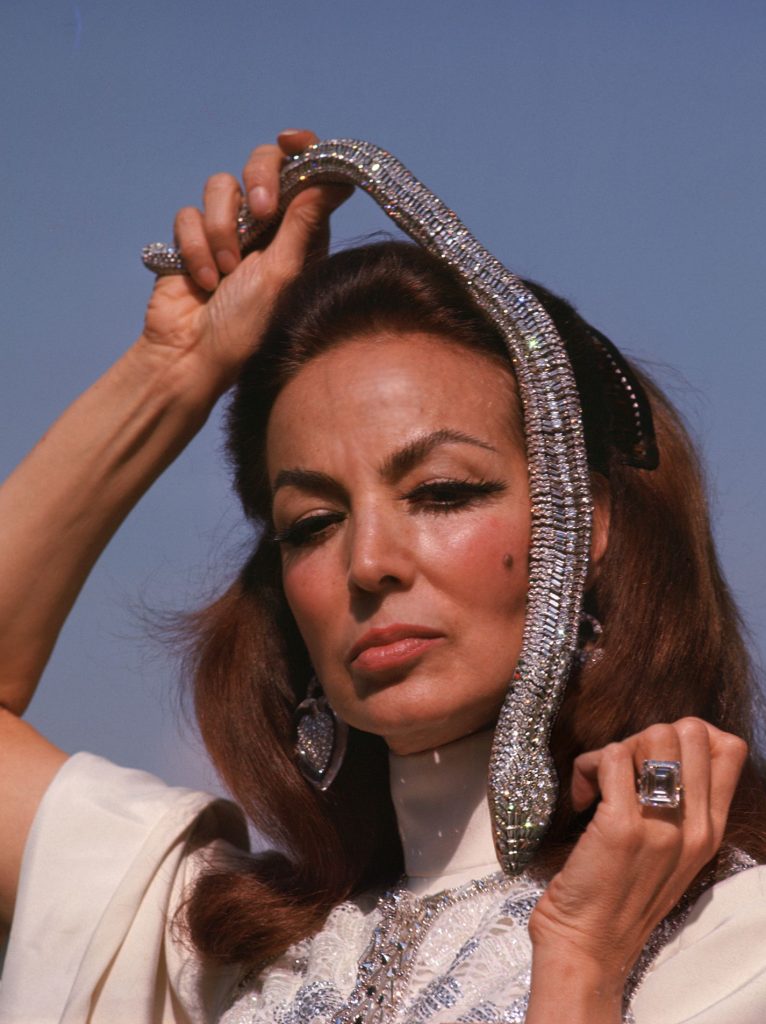
María Félix wearing her Snake necklace, commissioned from Cartier Paris in 1968. Photo: Ignacio Castillo, courtesy of Cartier.
The exhibition crescendoes to its mic drop with a section devoted to “María Félix and Icons of Elegance.” This section serves as an intriguing introduction to those unfamiliar with Félix, the iconic femme fatale of golden age Mexican cinema (she died in 2002 at age 88). “Maria Félix was this super powerful woman,” Mallet said. “She was not the best actress, her personality was so strong onscreen. The younger generation is super curious about her.”
Félix’s taste in jewelry matched her diva stature, and often veered toward the reptilian. Her most famous custom Cartier creation on display is an epic 1968 serpent necklace that is composed of 2,473 diamonds and took two years to forge. Another standout is her 1970s belt made from golden Mexican coins.
But the true heart of the show lies in the section devoted to visionary designer Jeanne Toussaint, who worked at the company from 1913 until her retirement in 1970. “I love the Toussaint pieces,” Escobedo said. “She was a groundbreaker. What she was doing was so different from the rest of jewelry design at the time.”

Oiseau Libéré brooch (1947) in gold, platinum, diamonds, sapphire, coral, and lapis lazuli by Cartier Paris. During World War II, various Cartier pieces featured caged birds, symbolizing occupied France. Once Paris was liberated, jewels were designed with the bird bursting from its cage. Photo: Nils Herrmann, courtesy of Cartier.
One Toussaint piece has particular resonance for Mallet. “When the Nazis took Paris, Jeanne Toussaint designed a brooch of a bird on a cage,” she said. “She got questioned for that, almost arrested. When Paris was liberated, she designed a bird that’s breaking free. The narrative behind this, this is what jewelry is about. Of course, it’s a beautiful piece, with coral, diamonds, lapis lazuli, and gold, but the story behind it accompanies a moment of humankind. It accompanies memory, history, culture, and this idea of marking special moments.” The brooch’s beauty derives from “not only the aesthetics of the jewelry,” Mallet added, “but also the symbolic content.”
“Cartier Design: A Living Legacy” is on view at Museo Jumex, Mexico City, through May 14, followed by editions in Hong Kong and a to-be-announced Middle East locale.